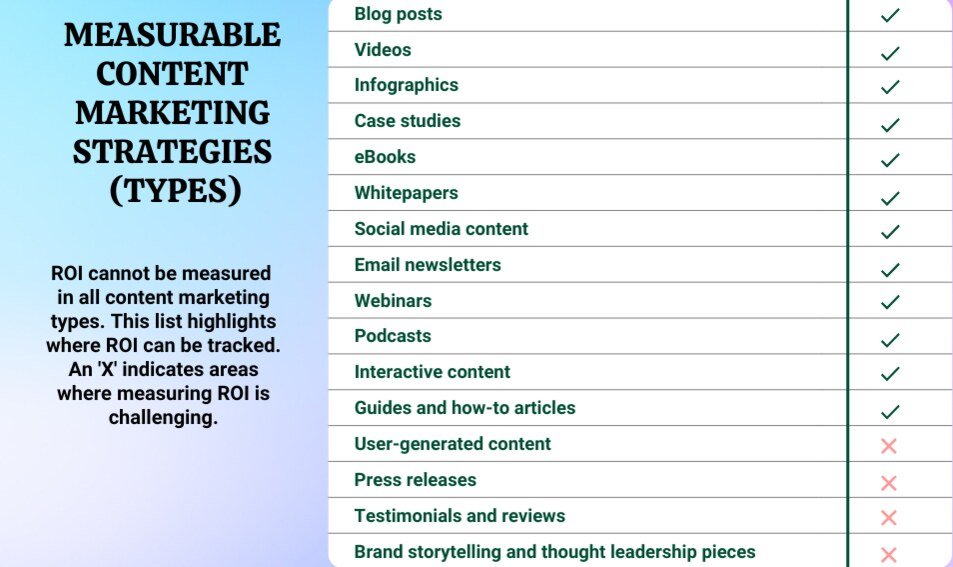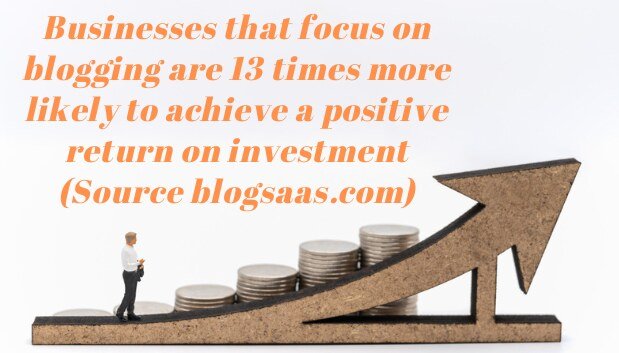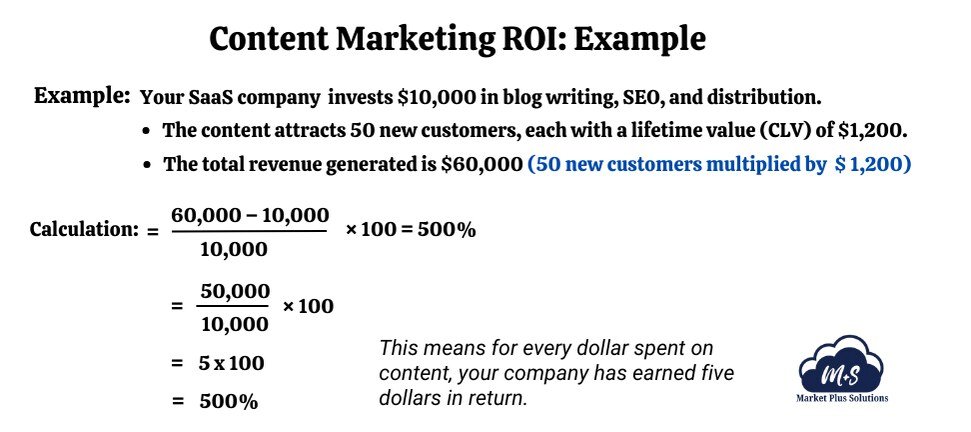What is Content Marketing ROI?
Content Marketing ROI (Return on Investment) measures the impact of your SaaS content marketing efforts relative to the costs involved.
Simply put, it answers a crucial question: Is your content generating real business value—whether through revenue, leads, brand awareness, or customer engagement—compared to what you invest in creating and distributing it? Content Marketing ROI quantifies how much your company gains for every dollar spent, offering a clear view of profits and losses. For example, if you invest $1,000 in blog creation, SEO, and promotion and generate $4,000 in revenue from leads acquired through that content, your ROI is evident.
Implementing effective content marketing strategies has led to 35% higher growth rates and 10% better retention rates for SaaS companies (Source: helloroketto.com)

However, SaaS content marketing isn’t about immediate wins.
Unlike paid ads that drive quick conversions, content builds momentum over time. Blog posts, case studies, and whitepapers continue attracting and converting customers long after publication, strengthening brand authority and fostering trust.
For small SaaS and IT businesses, tracking ROI isn’t just about proving success—it’s about making informed decisions. Every piece of content should contribute to measurable outcomes, whether increased website traffic, higher conversion rates, or improved customer retention. Measuring content marketing ROI also helps refine strategies, optimize budgets, and ensure content aligns with business goals.
What is SaaS Content Marketing?
SaaS content marketing encompasses everything your business shares online—from blog articles and case studies to social media posts and whitepapers.
But it’s more than just publishing content.
It’s a strategic approach focused on creating, distributing, and maintaining valuable, relevant, and consistent content that drives business growth.
For small SaaS and IT businesses, content marketing simplifies complex solutions, addresses customer pain points, and establishes industry authority. High-quality content doesn’t just explain what you offer—it builds credibility and nurtures long-term relationships. In fact, content marketing generates three times more leads per dollar spent than traditional advertising and costs 62% less (interodigital.com).

Content marketing generates three times more leads per $ spent than traditional advertising, while costing 62% less (interodigital), and 73% of B2B marketers report that content marketing is the best strategy for increasing leads and sales (firework)
Unlike traditional advertising, which interrupts audiences with sales-driven messages, SaaS content marketing educates, informs, and engages potential customers. And, today’s customers actively seek information before making decisions.
Companies that consistently provide relevant insights don’t just attract attention—they build trust and long-term loyalty. This is why Bill Gates’ famous statement, “Content is king,” still holds true. A well-executed SaaS content marketing strategy strengthens brand authority, enhances customer engagement, and ultimately drives sustainable business growth.

Importance of Content Marketing ROI
Measuring content marketing ROI is essential, especially for small SaaS and IT businesses refining their strategies for sustainable growth. In fact, 68% of businesses have increased their content marketing ROI using AI tools (source: Semrush). Tracking ROI helps assess content effectiveness, drive data-driven decisions, and allocate resources strategically to maximize impact.
How often should you measure content marketing ROI?
It depends on factors like campaign duration, content type, and business objectives.
However, most companies track results monthly, quarterly, and annually to ensure their content stays aligned with growth goals.
Benefits of Measuring Content Marketing ROI
Tracking content marketing ROI isn’t just about numbers—it’s about making smarter marketing decisions.
For small SaaS and IT businesses that invests in SaaS content marketing, measuring content marketing ROI helps assess performance, optimize resources, and refine strategies for maximum impact.
Here’s why it matters:

- Performance Assessment: Measuring content marketing ROI provides a clear view of how well your strategies perform. It identifies which content types and distribution channels drive the best results, allowing you to double down on what works and improve or eliminate what doesn’t.
- Resource Allocation: Understanding ROI ensures efficient budget allocation. By focusing investments on high-performing content and channels, small SaaS and IT businesses can maximize returns and avoid wasting resources on ineffective strategies.
- Strategic Planning: ROI insights shape future content strategies. They offer data-driven guidance on the most effective topics, formats, and promotional tactics to engage your target audience and drive measurable results.
- Justifying Marketing Spend: A strong ROI validates the impact of content marketing, making it easier to justify investments. Clear, data-backed results help secure stakeholder buy-in and ensure continued funding for content initiatives that drive business growth.
Investing in SaaS content marketing? Make sure your ROI justifies every effort. Discover how the right strategy can increase visibility, generate leads, and drive real business growth.
Why Investing in SaaS Content Marketing Matters
SaaS companies that prioritize content marketing have seen up to a 400% increase in lead generation (Source: Sixth City Marketing). High-value content doesn’t just enhance brand perception—it fosters customer loyalty and drives measurable business growth. In fact, businesses that publish blogs generate 67% more leads than those that don’t (HubSpot).
Unlike traditional marketing, which relies on paid ads and direct sales tactics, SaaS content marketing builds trust and credibility. Informative, well-researched content guides potential customers through their buying journey, increasing the likelihood that they’ll choose your solution over competitors. Companies that invest in content marketing don’t just attract leads—they nurture long-term relationships and improve customer retention.
By prioritizing meaningful content over disruptive advertising, small SaaS and IT businesses can create lasting value, turning prospects into advocates and positioning themselves as industry leaders. Also, companies that invest in SaaS content marketing see 6x higher conversion rates than those that don’t (ABG Essentials).
How to Measure Content Marketing ROI
Measuring ROI is fairly simple and straightforward.
Break down costs into:
- Content creation (writing, design, video production)
- Promotion and distribution (paid ads, SEO tools, social media campaigns)
- Technology and software (CMS, analytics, automation tools)
And follow the example as shown in the picture below:

KPIs in Content Marketing ROI
Measuring Content Marketing ROI requires tracking key performance indicators (KPIs) that reveal how effectively content contributes to business growth. Identifying the right KPIs helps small SaaS and IT businesses refine strategies, optimize efforts, and maximize returns.
Which KPIs Should You Focus On?
For small SaaS and IT companies, key metrics include lead conversion rate, organic traffic growth, marketing-qualified leads (MQLs), and customer lifetime value (CLV). If you’re running a brand awareness campaign, focus on social shares, backlinks, and brand mentions to gauge visibility and audience engagement.
While many KPIs can be tracked, five stand out as the most essential for small SaaS and IT businesses:
Financial KPIs (Revenue & Cost-Based Metrics)
Financial KPIs measure the direct financial impact of content marketing:
- Revenue Generated from Content – Total income influenced by content marketing efforts.
- Customer Acquisition Cost (CAC) – Cost of acquiring a new customer through content marketing.
- Customer Lifetime Value (CLV) – Total revenue a customer is expected to generate over their lifetime.
- Return on Investment (ROI) – Overall profitability of content marketing efforts.
Lead Generation & Conversion KPIs
Lead generation KPIs track how well content converts visitors into leads or customers:
- Lead Conversion Rate – Percentage of leads generated from content.
- Marketing Qualified Leads (MQLs) – Leads showing interest in content and likely to convert.
- Sales Qualified Leads (SQLs) – Leads engaged with content and ready for sales outreach.
- Cost Per Lead (CPL) – Cost of acquiring a lead through content marketing.
- Landing Page Conversion Rate – Percentage of users who take action on a landing page.
- Email Signups & Newsletter Subscriptions – Indicator of ongoing audience interest.
Engagement KPIs (User Interaction with Content)
Engagement KPIs measure how effectively content captures and retains audience attention:
- Time on Page – Average time visitors spend on a piece of content.
- Bounce Rate – Percentage of users leaving after viewing only one page.
- Pages per Session – Number of pages users navigate after engaging with content.
- Social Shares & Comments – Level of interaction on social platforms.
- Video Watch Time & Completion Rate – Percentage of a video watched by users.
SEO Performance KPIs
SEO performance KPIs measure how well content ranks and performs in search engines:
- Organic Traffic Growth – Increase in visitors from search engines.
- Keyword Rankings – Position of content for targeted search queries.
- Click-Through Rate (CTR) on SERP – Percentage of search users clicking on content.
- Backlinks Earned – Number of external sites linking to the content.
- Domain Authority (DA) Growth – Improvement in website authority over time.
Brand Awareness & Retention KPIs
Brand awareness and retention KPIs track content marketing’s impact on brand visibility and customer retention:
- Brand Mentions – Number of times the brand is mentioned online.
- Direct Traffic Growth – Increase in visitors who directly type the website URL.
- Customer Retention Rate – Percentage of users who continue engaging with content.
- Customer Feedback & Sentiment Analysis – Insights into audience perception and response to content.

Content marketing ROI isn’t just about measuring success—it’s about refining strategy. Every piece of content should be an asset, not an expense, delivering value that compounds over time.
Conclusion: Content Marketing ROI
ROI in content marketing, especially in SaaS content marketing, is crucial for tracking marketing efforts and making informed decisions—whether to scale up or pivot strategies.
Before launching a campaign, setting achievable and measurable goals is essential. Clear objectives help businesses track relevant metrics, attribute value correctly, and leverage analytics tools to determine content strategy effectiveness.
Measuring ROI isn’t a one-time process—it requires continuous evaluation. Regularly reviewing performance metrics, experimenting with different content formats, and refining strategies based on insights ensures sustained success. High-performing content should be repurposed or scaled, while underperforming assets should be revised or discontinued.
To measure ROI effectively, use tools like Google Analytics, CRM systems, marketing automation platforms, and SEO tools. The key to success is continuous optimization—adjusting tactics to ensure content marketing delivers tangible business outcomes.


